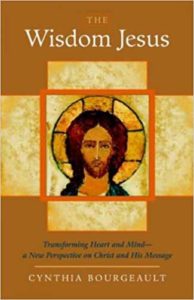While Jesus is typical of the wisdom tradition in his vision of what a whole and unified human being looks like, the route he lays out for getting there is very different from anything that had ever been seen on the planet up to that point (63). Cynthia Bourgeault, The Wisdom Jesus
My copy of The Wisdom Jesus is really falling apart.
The cover is faded from the sun that hits my bookshelf. The spine broken, pages falling out, underlines, notes everywhere, pages marked with different colored ink from different reads. Dog-eared. It’s a biblio-version of The Velveteen Rabbit, that well-loved character from our childhood stories, the stuffed toy rabbit who finally becomes real through receiving and giving love and his own complete self-giving to his boy. My The Wisdom Jesus has been well-loved and is very real.
This year marks my tenth anniversary with The Wisdom Jesus. It came to me when I’d just begun practicing Centering Prayer at a time of great need and personal crisis (my father’s death, a daughter’s seemingly undiagnosable illness) and accompanied me through this season in a strong and tangible way. It has changed my life forever.
Each word, sentence, and chapter, but especially Chapter 6, are beautiful and heartbreakingly real. Cynthia presents a reality I longed for, but which seemed just beyond my grasp, showing a way to work with this life I’ve been given, so I might be of use, to myself and to the world.
Maybe right now you’re like I was back then, facing a life-challenge, yearning for help, or just for something to hold onto. If this is your first reading, I couldn’t be happier for you. Relax and enjoy it. Let it speak to you and drink it in, as I certainly did and have. What a gift it is as you get to know Jesus, as he becomes real in new, vivid, and maybe surprising ways through Cynthia’s words. You may have to let go of the Jesus you thought you knew to meet the Wisdom Jesus. I did.
On my first reading, I remember a sounding inside of an inner recognition and knowing that this was the real deal. Cynthia’s Wisdom Jesus connected dots, cleared confusion, and harmonized dissonance from everything I’d learned all my life about Jesus.
Each time I read this book, it’s a new book to me, as I glean new insights. The beauty and majesty of Chapters 6 and 7 never fail to take my breath away. In these rich, dense, and gorgeously written chapters, Cynthia takes us by the hand and maps the landscape of kenotic love to the heart of the heart of Jesus and, in turn, provides a clear road map for our own challenges and moment-to-moment living. The chapters fill me with hope, courage, and a means whereby to embody in some small way these finer qualities.
Kenosis: The Path to Self-Emptying Love
At the end of Chapter 5, Cynthia teases “This kenotic spirituality (self-emptying as the path to fullness) is in my opinion Jesus’s unique and profoundly original contribution to the spiritual consciousness of humankind.”
She begins Chapter 6, this portal to love, with the beautiful hymn from Philippians 2:9-16 which lays out the terrain of this strange word—kenosis—and how it was Jesus’s modus operandi. Letting go of the egoic operating system. Letting go, period. Descent. Not clinging. Self-emptying. Giving. Welcoming. Including.
We see how Jesus’s path is the “road less traveled” compared to other great spiritual paths which are all about up, up, up. Rising. Energy focused, concentrated. Asceticism. Containment. Self-mastery. The “salmon swimming upstream” models of perennial wisdom that teach the way to God is up.
For me this upward path feels like the music of Handel’s “Hallelujah Chorus,” where we all jump to our feet. Contrastingly, kenosis is a falling, a dropping, like in the last lines from Denise Levertov’s poem “To Live in the Mercy of God”:
To float, upheld,
as salt water
would hold you,
once you dared.
Since we’re not familiar with kenosis, Cynthia shares two beautiful examples of the kenotic path, in the stories of “The Gifts of the Magi” and Babette’s Feast. We see kenosis in action in the total giving of self and self-interest. In “no-holes-barred generosity” and “extravagant acts of abundance” (68).
No boundaries. “Messy, free-wheeling. Largeness of spirit” (69). That’s Jesus for you. That’s how he lived and what he taught. “Do not store up treasures on earth,” “Do not hoard,” “Don’t strive,” “Don’t be afraid,” “Do not cling. Not even to life itself” (70). In fact—”Don’t resist, don’t renounce. Embrace everything. Your life. The people in it. Everything.” It’s all over all the gospels once you have eyes to see it.
This is the good news! Until Cynthia throws in the kicker. “It only costs everything” (70).
No wonder nobody got it. It blew their minds. It was new and it was confusing. And the cost was too high. It was so much easier to return to rules and renunciation, to climbing ladders and pecking orders.
Join the Dance
But near the end of this chapter in “Dancing with the Trinity,” we learn that some folks did get it—in Cappadocia in the fourth century, in a great contemplative wisdom school! These three great Cappadocian teachers began to “articulate and tease into comprehensible form the eternal archetype of the Trinity” (71). Not as persons but as a “flow of energy between the persons.” The key image from Rumi’s poem, “The Waterwheel,” aptly describes this constant motion of the Trinity—a waterwheel eternally turning, filling, giving itself away and then refilling.
Seen as flow, the Trinity becomes an “icon of self-giving love” (71). Another Trinitarian image is of a dance of self-emptying—the unbroken, eternal dance of God, who “moves and flows so that love become manifest as the unified field of all reality” (72).
I Want to Be Like Jesus—But How?
Okay—that’s Jesus. But how do I become a real person and live a life of kenosis? Cynthia posits a starting point which is simple but not easy: Centering Prayer meditation (as described in Chapter 12).
Deciding to let go of thoughts and return to a state of availability to God for 20 minutes twice a day, Centering Prayer is a “warm” practice that works on the level of your intention. When you catch yourself thinking, you use a sacred word as a kind of windshield-wiper, to clear your mental space and gently return to receptivity. As Thomas Keating says, it’s a short vacation from yourself. In Chapter 12 Cynthia provides basic operating instructions for this practice, which she elaborates on in much greater detail in Centering Prayer and Inner Awakening.
So how does this work through the rest of the hours of your life not spent in meditation? Just watch. Kenosis has a way of seeping in. It’s a felt body sense first. Try this: clench your fists, lock your jaw, tense every muscle of the body, then release it. There. Kenosis. Soon, the muscle memory you build in meditation takes over and allows you to let go in situations life brings you. You let that obnoxious man butt the line at CVS. You hold back your clever, snarky retort. You listen to your wife tell her favorite story—for the millionth time.
And so, we practice, all beginners. We begin, again and again. Each moment presents an opportunity to let go, to bring what we have to offer. To be of some use.
The Divine Alchemy
In her magnificent final section of Chapter 6, Cynthia’s writing reaches a crescendo. Here she describes how the sacred alchemy of giving and receiving, of Divine flow, plays out in our own little lives to connect us to the Trinity’s dance. “As we practice in daily life, in our acts of compassion, kindness, and self-emptying, both at the level of our doing and even more at the level of our being, something is catalyzed out of that self-emptying which is pure divine substance” (73).
No matter how fragmented, disconnected, or imperfect our efforts, “Subtle qualities of divine love essential to the well-being of this planet are released through our actions and flow out into the world as miracle, healing, and hope” (73).
Subtle, micro-decisions we make to choose to open and not brace, to turn towards pain, sorrow, need, want—rather than run away. To decide to give more not less. Even in the utter darkness of a concentration camp, in occupied Paris, in the divided United States.
Kenosis is found in action, in gesture. The young lovers running out and selling their prized possessions, to give gifts to their beloved. Babette’s glorious meal, costing her freedom. The Velveteen Rabbit, who stays and offers comfort and succor to his boy racked with scarlet fever, then after all is well is tossed on the rubbish heap with the rest of the infected bedding to be burned.
Many parables portray it—the father racing down the road to meet his prodigal son, the woman selling all she has for the pearl of great price. Etty Hillesum giving up her freedom, transported to a concentration camp. Gurdjieff’s occupied Paris pantry of plenty—feeding the hungry. Moving, flowing. Kenosis in action. The Trinity dancing. Giving and receiving. The Divine Exchange pouring out and filling and pouring out again.
We can become the river itself, Cynthia assures us, “which circulates through all things as the hidden dynamism of love” (74). Just like Jesus.
It’s All About Love
Love permeates Chapter 7 as we explore “Jesus as Tantric Master” and analyze his relationship with his beloved disciple, Mary Magdalene—and then the terribly twisted rest of the story.
The problem starts, Cynthia explains, with equating Jesus with John the Baptist, as the two couldn’t have been more different. John, an Essene, the acetic in the wilderness alone, feasting on wild locust and honey. The upward path. Repentance and renunciation (76). Jesus carried out his ministry in the middle of the marketplace. He taught, healed, laughed, danced, dined as a brother and a friend (77), taught and preached a “message of complete self-emptying or self-outpouring” (78).
From there, Cynthia explains how our term “ihidaya” morphed from “the single one” to just “single”—translated celibate.
Next, she carefully explains the difference between physical celibacy and the spiritual quality of chastity. Chastity from a kenotic perspective is a singleness of non-attachment or non-clinging in relation to all things—people included.
Mary Magdalene: Apostle to the Apostles
And then there’s Jesus and Mary Magdalene. “She saw that he really did come from another realm and that his purpose was to make that realm manifest here and now” (83). Mary understood the integral, non-dual vision of wholeness Jesus was about. Through their work together they beat all odds. And the titillating Da Vinci Code controversy—celibate or not celibate—misses the larger point. We should be overjoyed about Jesus’s relationship with a human beloved—it’s a “cause for joy not consternation” (80).
But their relationship did turn everything upside down and certainly did not go over well—as time and the Nag Hammadi gospels show. Mary Magdalene of all the disciples did the work, moved beyond her egoic mind to become a living spirit in her own right. That’s how she could hold her post during the crucifixion and burial to resurrection morning (84).
Whatever the nature of their physical relationship, the deep, pure love between them reveals itself so poignantly in that morning scene in the garden, with Jesus’s words to Mary, “Do not cling to me.”
How did the other disciples take to this? They’d witnessed Jesus and Mary “transcend[ed] their male-femaleness to become living spirits” (86), and knew that Mary, a woman, alone of all the inner circle had reached this point. It was too much, and they couldn’t fathom it. They changed the narrative, maligned her, returned to rules and regulations, to the upward path of asceticism, and later affirmed that of course Jesus was celibate, and this was the only way to become a first-class Christian citizen.
At the end of Chapter 7, Cynthia explains the crux of the problem in this colossal misunderstanding is picturing God as an object of love—a someone or some thing rather only and always as the subject of love. This love flows through our lives, our relationships, opportunities, challenges, choices—in each and every moment. “No one—and nothing is excluded” (87).
She concludes, “Anyone who is willing to take up the burden of the much more difficult task—not the manageable complexity of rules and regulations, but the unmanageable simplicity of being present to your life in love—that person is walking the path of Jesus” (88).
This short sketch of Mary Magdalene’s true role in the Jesus community and relationship to Jesus as “apostle to the apostles” is fleshed out in Cynthia’s beautiful book, The Meaning of Mary Magdalene. Here, Mary Magdalene stands as proof that kenotic love is possible for human beings to achieve, both individually and in relationship with a beloved.
The Real Jesus—a New Reality
Again, if this is your first reading of The Wisdom Jesus, savor these chapters.
Get your own taste of kenosis through practicing Centering Prayer, ponder the power of kenotic love, of singleness, of the dynamic dance of the Trinity through time, space, dimensions, worlds. There are examples every day, all around us, if we have eyes to see. Now that we know the real story, we can see the real Jesus. And we accompany him now, in Cynthia’s next chapters, on his long and arduous kenotic path to Easter.
Liz Keller Whitehurst is a writer and teacher, the author of Messenger, and author/creator of the serial podcast MESSENGER: A NOVEL IN 16 EPISODES. A long-time student of Cynthia Bourgeault’s, she’s currently helping to co-facilitate a The Wisdom Jesus Wisdom Book Circle and Wisdom Here, Now, a monthly meeting of folks from Virginia and Tennessee. She’s also helping with editing for Wisdom Waypoints. Liz lives in the oldest part of Richmond, Virginia in a 1891 home just overlooking the James River.
Here are the links to the previous posts in this series:
The Wisdom Jesus Book Circles launching January 31, 2023
The Wisdom Jesus: Chapters Three, Four and Five
Image credits in order: Pexels: Darya Sanniko; Pexels: Quang Nguyễn Vinh; Pexels: Hilmi Isilak; Photograph: Liz Whitehurst; Original Art: Joy Whitehurst







